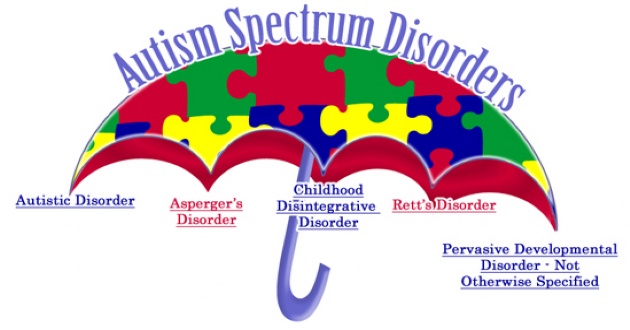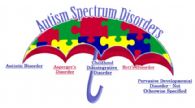What is an Autism Spectrum Disorder (ASD)?
Autism spectrum disorders are a now very common childhood disability. In fact, more than 1<>percentage<> of children will be diagnosed with an autism spectrum disorder prior to the age of 7. This means that as a parent, daycare provider, teacher or friend, you will most likely be touched in some way by autism. The most current statistics indicate that 1 in 88 children will receive a diagnosis [1]. That's more than the prevalence rates of pediatric cancer, pediatric diabetes, and childhood AIDS, combined [2]. The trend appears to be the same in Quebec, with the annual rate of ASDs increasing steadily over the last few years [3], [4].
An autism spectrum disorder (ASD) is a neurodevelopmental disorder that is typically diagnosed in childhood. This means that it affects the brain development of children, and although signs are discernible at quite a young age (as early as 10 months of age), we typically will diagnose a child at about the time that we would expect speech to develop (around 18 to 24 months of age). ASD affects the following areas of development; social-communication skills and social interaction. Difficulty in developing both communication and social skills are accompanied by restrictive or repetitive behaviours (such as lining up objects, hand flapping or not playing functionally with toys) [5],[6]. Please see the early signs chart below.
Terminology has evolved over the last few years, so the words we use to refer to this condition can be confusing. In Quebec, we use many names to refer to the same condition. Moreover, we live in a bilingual province, which makes the task of untangling our common ‘lingo ' even more confusing. Here is a diagram, in both languages, that can help the reader to understand what is meant by all the terms that are currently used to describe children with ASDs.
(Terminology in French)
Troubles du spectre de l'autisme - (précédemment Troubles envahissants du développement)
Autism spectrum disorders are a now very common childhood disability. In fact, more than 1<>percentage<> of children will be diagnosed with an autism spectrum disorder prior to the age of 7. This means that as a parent, daycare provider, teacher or friend, you will most likely be touched in some way by autism. The most current statistics indicate that 1 in 88 children will receive a diagnosis [1]. That's more than the prevalence rates of pediatric cancer, pediatric diabetes, and childhood AIDS, combined [2]. The trend appears to be the same in Quebec, with the annual rate of ASDs increasing steadily over the last few years [3], [4].
An autism spectrum disorder (ASD) is a neurodevelopmental disorder that is typically diagnosed in childhood. This means that it affects the brain development of children, and although signs are discernible at quite a young age (as early as 10 months of age), we typically will diagnose a child at about the time that we would expect speech to develop (around 18 to 24 months of age). ASD affects the following areas of development; social-communication skills and social interaction. Difficulty in developing both communication and social skills are accompanied by restrictive or repetitive behaviours (such as lining up objects, hand flapping or not playing functionally with toys) [5],[6]. Please see the early signs chart below.
Terminology has evolved over the last few years, so the words we use to refer to this condition can be confusing. In Quebec, we use many names to refer to the same condition. Moreover, we live in a bilingual province, which makes the task of untangling our common ‘lingo ' even more confusing. Here is a diagram, in both languages, that can help the reader to understand what is meant by all the terms that are currently used to describe children with ASDs.
(Terminology in French)
Troubles du spectre de l'autisme - (précédemment Troubles envahissants du développement)
- Trouble autistique
- Syndrome d’asperger
- Trouble désintégratif de l’enfance
- Syndrome de Rett
- Trouble envahissant du développement- Non Spécifié
Autism Spectrum Disorders - (previously Pervasive developmental disorders)
So what are the first signs?
In 2008, the Miriam Foundation published the Canadian best practice guidelines for the assessment and diagnosis of ASDs in very young children [8]. What’s important is to recognize the early signs, because early recognition will lead to early intervention and the greatest possible gains for each child. Please see the table entitled Early Signs.
Getting support
Should you be concerned about your child’s development, the “wait and see” approach is not recommended! The first approach should be to visit the pediatrician. The second is to make an appointment with the CLSC to speak about your concerns, as they are the gateway to referral to publicly funded intervention services. For a full assessment, your pediatrician will refer you to either a publicly-funded developmental clinic (in Laval, the Clinique de développement du Centre ambulatoire régional de Laval (CARL) or to private practitioners who are trained in diagnosis of ASDs. Going privately can be expensive, but it can also speed up the process. Recent changes in health laws in the province now allow either a trained licensed psychologist or medical doctor in the area to assess and determine diagnosis of ASD. Early intervention, of course, is of utmost importance. Public services (CRDITED Normand-Laramée in Laval) offer early intervention, but parents will need a diagnosis and to be referred by their local CLSC.
The key is awareness and being proactive! We must therefore become more knowledgeable as our children deserve to be screened early so that they may receive care and proper educational resources to enable them to reach their full potential!
For more information, please visit our websites for resources;
www.miriamfoundation.ca & www.goldlearningcentre.com
- Autistic Disorder
- Asperger Syndrome
- Childhood Disintegrative Disorder
- Rett Syndrome
- Pervasive Developmental Disorder-Not Otherwise Specified
So what are the first signs?
In 2008, the Miriam Foundation published the Canadian best practice guidelines for the assessment and diagnosis of ASDs in very young children [8]. What’s important is to recognize the early signs, because early recognition will lead to early intervention and the greatest possible gains for each child. Please see the table entitled Early Signs.
Getting support
Should you be concerned about your child’s development, the “wait and see” approach is not recommended! The first approach should be to visit the pediatrician. The second is to make an appointment with the CLSC to speak about your concerns, as they are the gateway to referral to publicly funded intervention services. For a full assessment, your pediatrician will refer you to either a publicly-funded developmental clinic (in Laval, the Clinique de développement du Centre ambulatoire régional de Laval (CARL) or to private practitioners who are trained in diagnosis of ASDs. Going privately can be expensive, but it can also speed up the process. Recent changes in health laws in the province now allow either a trained licensed psychologist or medical doctor in the area to assess and determine diagnosis of ASD. Early intervention, of course, is of utmost importance. Public services (CRDITED Normand-Laramée in Laval) offer early intervention, but parents will need a diagnosis and to be referred by their local CLSC.
The key is awareness and being proactive! We must therefore become more knowledgeable as our children deserve to be screened early so that they may receive care and proper educational resources to enable them to reach their full potential!
For more information, please visit our websites for resources;
www.miriamfoundation.ca & www.goldlearningcentre.com
Early Signs Chart
At 12 months;
Dr. Nathalie Garcin / Psychologist
Nathalie Garcin, PhD is a clinical psychologist and is the Executive director of the Gold Centre, Montreal, Québec. Since 2010, Dr Garcin has been developing the Gold Centre’s not-for-profit endeavours, through the generous funding of its partner, the Miriam Foundation, with the goal of offering services, research and knowledge transfer activities for people with autism spectrum disorders and developmental disabilities. The Gold Centre operates out of Montreal, Quebec. Its programs include 2 intensive centre-based intervention programs for young children with ASDs and other developmental disabilities, an interdisciplinary diagnostic centre, an educational resources lending bank, a knowledge transfer centre, adult leisure programs and research endeavours for more information; www.miriamfoundation.ca
At 12 months;
- Your child doesn’t babble or babbles less than you would expect
- Your child doesn’t gesture (pointing, waiving bye, bye, etc)
- Your child doesn’t respond, or rarely responds, when you call his name
- Your child has no single words or very few
- Your child does not use 2-word spontaneous phrases, not including echolalia (parroting) or repetitive speech
- You child seems to regress or lose language or social skills
- Your child doesn't look to share attention with you (for example, interest with you, or following your point)
Dr. Nathalie Garcin / Psychologist
Nathalie Garcin, PhD is a clinical psychologist and is the Executive director of the Gold Centre, Montreal, Québec. Since 2010, Dr Garcin has been developing the Gold Centre’s not-for-profit endeavours, through the generous funding of its partner, the Miriam Foundation, with the goal of offering services, research and knowledge transfer activities for people with autism spectrum disorders and developmental disabilities. The Gold Centre operates out of Montreal, Quebec. Its programs include 2 intensive centre-based intervention programs for young children with ASDs and other developmental disabilities, an interdisciplinary diagnostic centre, an educational resources lending bank, a knowledge transfer centre, adult leisure programs and research endeavours for more information; www.miriamfoundation.ca
[1] Centers for Disease Control and Prevention (2012). Prevalence of Autism Spectrum Disorders — Autism and Developmental Disabilities Monitoring Network, 14 Sites, United States, 2008, Morbidity and Mortality Weekly Report (MMWR) Surveillance Summaries, March 30, 2012 / 61 (SS03);1-1.
[2] Autismspeaks.org (2013)Comparison based on the prevalence statistics of the Child & Adolescent Health Measurement Initiative
[3] Noiseux, M. (2008). Portrait épidémiologique des TED chez les enfants du Québec. L’Express. Le Fédération québécoise de l’autisme. [www.autisme.qc.ca/TED/les-ted-en-chiffres/portrait-epidemiologique-des-ted-chez-les-enfants-du quebec.html].
[3] Noiseux, M. (2008). Portrait épidémiologique des TED chez les enfants du Québec. L’Express. Le Fédération québécoise de l’autisme. [www.autisme.qc.ca/TED/les-ted-en-chiffres/portrait-epidemiologique-des-ted-chez-les-enfants-du quebec.html].
[4] Autismspeaks.org (2013) Comparison based on the prevalence statistics of the Child & Adolescent Health Measurement Initiative
[5][6] www.Dsm5.org
 PICK-UP LOCATIONS
Get a copy of LFM!
PICK-UP LOCATIONS
Get a copy of LFM!
TERMS & CONDITIONS Privacy | Terms
ISSN (ONLINE) 2291-1677
ISSN (PRINT) 2291-1677
Website by ZENxDESIGN
[7] American Psychiatric Association, APA.org
[8] Nachshen, J., Garcin, N., Moxness, K., Tremblay, Y., Hutchinson, P., Lachance, A., Beaurivage, M., Breitenbach, M., Bryson, S., Burack, J., Caron, C., Condillac, R. A.,Cornick, A., Ouellette-Kuntz, H., Joseph, S., Rishikof, E., Sladeczek, I. E., Steiman, M., Tidmarsh, L., Zwaigenbaum, L., Fombonne, E., Szatmari, E., Martin-Storey, A., & Ruttle, P.L. (2008). Guide des pratiques exemplaires canadiennes en matière de dépistage, d’évaluation et de diagnostic des troubles du spectre de l’autisme chez les enfants en bas âge. Fondation Miriam, Montréal, Québec [www.miriamfoundation.ca/fr].
Articles ~e 105,7 Rythme FM 4 chemins Annual Teacher Appreciation Contest Appui Laval Arts & Culture Ballet Eddy Toussaint Camps THIS ISSUE MORE...
CONTESTS Enter our contests
CONTESTS Enter our contests
CALENDAR
Events & Activities
COMMUNITY Posts Events
PUBLICATIONS Our Magazine Family Resource Directory
LFM BUSINESS NETWORK Learn more
COUPONS Click to save!
COMMUNITY Posts Events
PUBLICATIONS Our Magazine Family Resource Directory
LFM BUSINESS NETWORK Learn more
COUPONS Click to save!
SUBSCRIPTIONS
Subscribe to the magazine
Un-Subscribe
E-NEWSLETTER Subscribe to our E-newsletter Un-Subscribe
WRITE FOR US Guidelines & Submissions
POLLS Vote today!
E-NEWSLETTER Subscribe to our E-newsletter Un-Subscribe
WRITE FOR US Guidelines & Submissions
POLLS Vote today!
ADVERTISERS
How to & Media guide
Pay your LFM invoice
SUGGESTIONS Reader's Survey Suggest a Listing
LFM About Us Our Mission Giving Back Contact Us
SUGGESTIONS Reader's Survey Suggest a Listing
LFM About Us Our Mission Giving Back Contact Us
 PICK-UP LOCATIONS
Get a copy of LFM!
PICK-UP LOCATIONS
Get a copy of LFM!
TERMS & CONDITIONS Privacy | Terms
ISSN (ONLINE) 2291-1677
ISSN (PRINT) 2291-1677
Website by ZENxDESIGN

 In The Latest Issue:
In The Latest Issue:


 BY:
BY: 
Tweet
Share